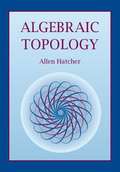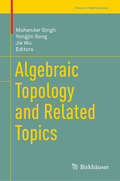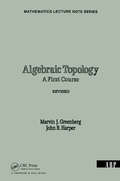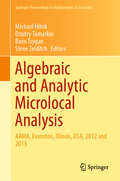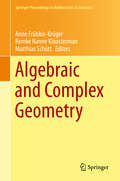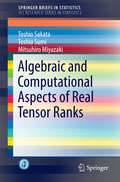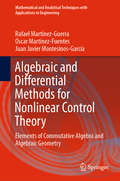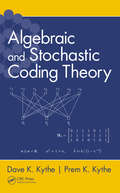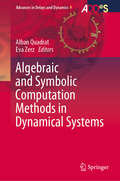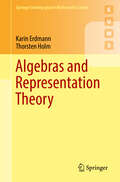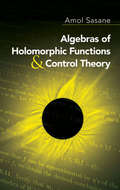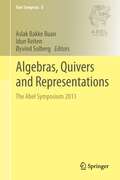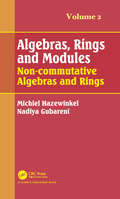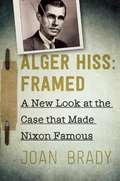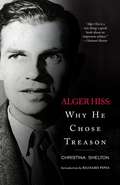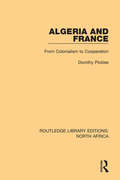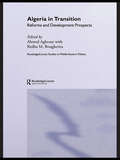- Table View
- List View
Algebraic Topology
by Allen HatcherIn most major universities one of the three or four basic first-year graduate mathematics courses is algebraic topology. This introductory text is suitable for use in a course on the subject or for self-study, featuring broad coverage and a readable exposition, with many examples and exercises. The four main chapters present the basics: fundamental group and covering spaces, homology and cohomology, higher homotopy groups, and homotopy theory generally. The author emphasizes the geometric aspects of the subject, which helps students gain intuition. A unique feature is the inclusion of many optional topics not usually part of a first course due to time constraints: Bockstein and transfer homomorphisms, direct and inverse limits, H-spaces and Hopf algebras, the Brown representability theorem, the James reduced product, the Dold-Thom theorem, and Steenrod squares and powers.
Algebraic Topology and Related Topics (Trends in Mathematics)
by Jie Wu Mahender Singh Yongjin SongThis book highlights the latest advances in algebraic topology, from homotopy theory, braid groups, configuration spaces and toric topology, to transformation groups and the adjoining area of knot theory. It consists of well-written original research papers and survey articles by subject experts, most of which were presented at the “7th East Asian Conference on Algebraic Topology” held at the Indian Institute of Science Education and Research (IISER), Mohali, Punjab, India, from December 1 to 6, 2017. Algebraic topology is a broad area of mathematics that has seen enormous developments over the past decade, and as such this book is a valuable resource for graduate students and researchers working in the field.
Algebraic Topology: A First Course (Contemporary Mathematics Ser. #Vol. 58)
by Marvin J. GreenbergGreat first book on algebraic topology. Introduces (co)homology through singular theory.
Algebraic Topology: VIASM 2012–2015 (Lecture Notes in Mathematics #2194)
by H. V. Hưng Nguyễn Lionel SchwartzHeld during algebraic topology special sessions at the Vietnam Institute for Advanced Studies in Mathematics (VIASM, Hanoi), this set of notes consists of expanded versions of three courses given by G. Ginot, H. -W. Henn and G. Powell. They are all introductory texts and can be used by PhD students and experts in the field. Among the three contributions, two concern stable homotopy of spheres: Henn focusses on the chromatic point of view, the Morava K(n)-localization and the cohomology of the Morava stabilizer groups. Powell's chapter is concerned with the derived functors of the destabilization and iterated loop functors and provides a small complex to compute them. Indications are given for the odd prime case. Providing an introduction to some aspects of string and brane topology, Ginot's contribution focusses on Hochschild homology and its generalizations. It contains a number of new results and fills a gap in the literature.
Algebraic and Analytic Microlocal Analysis: Aama, Evanston, Illinois, Usa, 2012 And 2013 (Springer Proceedings in Mathematics & Statistics #269)
by Michael Hitrik Dmitry Tamarkin Boris Tsygan Steve ZelditchThis book presents contributions from two workshops in algebraic and analytic microlocal analysis that took place in 2012 and 2013 at Northwestern University. Featured papers expand on mini-courses and talks ranging from foundational material to advanced research-level papers, and new applications in symplectic geometry, mathematical physics, partial differential equations, and complex analysis are discussed in detail. Topics include Procesi bundles and symplectic reflection algebras, microlocal condition for non-displaceability, polarized complex manifolds, nodal sets of Laplace eigenfunctions, geodesics in the space of Kӓhler metrics, and partial Bergman kernels. This volume is a valuable resource for graduate students and researchers in mathematics interested in understanding microlocal analysis and learning about recent research in the area.
Algebraic and Complex Geometry: In Honour of Klaus Hulek's 60th Birthday (Springer Proceedings in Mathematics & Statistics #71)
by Anne Frühbis-Krüger Remke Nanne Kloosterman Matthias SchüttSeveral important aspects of moduli spaces and irreducible holomorphic symplectic manifolds were highlighted at the conference "Algebraic and Complex Geometry" held September 2012 in Hannover, Germany. These two subjects of recent ongoing progress belong to the most spectacular developments in Algebraic and Complex Geometry. Irreducible symplectic manifolds are of interest to algebraic and differential geometers alike, behaving similar to K3 surfaces and abelian varieties in certain ways, but being by far less well-understood. Moduli spaces, on the other hand, have been a rich source of open questions and discoveries for decades and still continue to be a hot topic in itself as well as with its interplay with neighbouring fields such as arithmetic geometry and string theory. Beyond the above focal topics this volume reflects the broad diversity of lectures at the conference and comprises 11 papers on current research from different areas of algebraic and complex geometry sorted in alphabetic order by the first author. It also includes a full list of speakers with all titles and abstracts.
Algebraic and Computational Aspects of Real Tensor Ranks (SpringerBriefs in Statistics)
by Toshio Sakata Toshio Sumi Mitsuhiro MiyazakiThis book provides comprehensive summaries of theoretical (algebraic) and computational aspects of tensor ranks, maximal ranks, and typical ranks, over the real number field. Although tensor ranks have been often argued in the complex number field, it should be emphasized that this book treats real tensor ranks, which have direct applications in statistics. The book provides several interesting ideas, including determinant polynomials, determinantal ideals, absolutely nonsingular tensors, absolutely full column rank tensors, and their connection to bilinear maps and Hurwitz-Radon numbers. In addition to reviews of methods to determine real tensor ranks in details, global theories such as the Jacobian method are also reviewed in details. The book includes as well an accessible and comprehensive introduction of mathematical backgrounds, with basics of positive polynomials and calculations by using the Groebner basis. Furthermore, this book provides insights into numerical methods of finding tensor ranks through simultaneous singular value decompositions.
Algebraic and Differential Methods for Nonlinear Control Theory: Elements of Commutative Algebra and Algebraic Geometry (Mathematical and Analytical Techniques with Applications to Engineering)
by Rafael Martínez-Guerra Oscar Martínez-Fuentes Juan Javier Montesinos-GarcíaThis book is a short primer in engineering mathematics with a view on applications in nonlinear control theory. In particular, it introduces some elementary concepts of commutative algebra and algebraic geometry which offer a set of tools quite different from the traditional approaches to the subject matter. This text begins with the study of elementary set and map theory. Chapters 2 and 3 on group theory and rings, respectively, are included because of their important relation to linear algebra, the group of invertible linear maps (or matrices) and the ring of linear maps of a vector space. Homomorphisms and Ideals are dealt with as well at this stage. Chapter 4 is devoted to the theory of matrices and systems of linear equations. Chapter 5 gives some information on permutations, determinants and the inverse of a matrix. Chapter 6 tackles vector spaces over a field, Chapter 7 treats linear maps resp. linear transformations, and in addition the application in linear control theory of some abstract theorems such as the concept of a kernel, the image and dimension of vector spaces are illustrated. Chapter 8 considers the diagonalization of a matrix and their canonical forms. Chapter 9 provides a brief introduction to elementary methods for solving differential equations and, finally, in Chapter 10, nonlinear control theory is introduced from the point of view of differential algebra.
Algebraic and Differential Topology
by R.V. GamkrelidzeAlgebraic and Differential Topology presents in a clear, concise, and detailed manner the fundamentals of homology theory. It first defines the concept of a complex and its Betti groups, then discusses the topolgoical invariance of a Betti group. The book next presents various applications of homology theory, such as mapping of polyhedrons onto other polyhedrons as well as onto themselves. The third volume in L.S. Pontryagin's Selected Works, this book provides as many insights into algebraic topology for today's mathematician as it did when the author was making his initial endeavors into this field.
Algebraic and Stochastic Coding Theory
by Prem K. Kythe Dave K. KytheUsing a simple yet rigorous approach, Algebraic and Stochastic Coding Theory makes the subject of coding theory easy to understand for readers with a thorough knowledge of digital arithmetic, Boolean and modern algebra, and probability theory. It explains the underlying principles of coding theory and offers a clear, detailed description of each code. More advanced readers will appreciate its coverage of recent developments in coding theory and stochastic processes. After a brief review of coding history and Boolean algebra, the book introduces linear codes, including Hamming and Golay codes. It then examines codes based on the Galois field theory as well as their application in BCH and especially the Reed–Solomon codes that have been used for error correction of data transmissions in space missions. The major outlook in coding theory seems to be geared toward stochastic processes, and this book takes a bold step in this direction. As research focuses on error correction and recovery of erasures, the book discusses belief propagation and distributions. It examines the low-density parity-check and erasure codes that have opened up new approaches to improve wide-area network data transmission. It also describes modern codes, such as the Luby transform and Raptor codes, that are enabling new directions in high-speed transmission of very large data to multiple users. This robust, self-contained text fully explains coding problems, illustrating them with more than 200 examples. Combining theory and computational techniques, it will appeal not only to students but also to industry professionals, researchers, and academics in areas such as coding theory and signal and image processing.
Algebraic and Symbolic Computation Methods in Dynamical Systems (Advances in Delays and Dynamics #9)
by Alban Quadrat Eva ZerzThis book aims at reviewing recent progress in the direction of algebraic and symbolic computation methods for functional systems, e.g. ODE systems, differential time-delay equations, difference equations and integro-differential equations. In the nineties, modern algebraic theories were introduced in mathematical systems theory and in control theory. Combined with real algebraic geometry, which was previously introduced in control theory, the past years have seen a flourishing development of algebraic methods in control theory. One of the strengths of algebraic methods lies in their close connections to computations. The use of the above-mentioned algebraic theories in control theory has been an important source of motivation to develop effective versions of these theories (when possible). With the development of computer algebra and computer algebra systems, symbolic methods for control theory have been developed over the past years. The goal of this book is to propose a partial state of the art in this direction. To make recent results more easily accessible to a large audience, the chapters include materials which survey the main mathematical methods and results and which are illustrated with explicit examples.
Algebras and Representation Theory (Springer Undergraduate Mathematics Ser.)
by Karin Erdmann Thorsten HolmThis carefully written textbook provides an accessible introduction to the representation theory of algebras, including representations of quivers.The book starts with basic topics on algebras and modules, covering fundamental results such as the Jordan-Hölder theorem on composition series, the Artin-Wedderburn theorem on the structure of semisimple algebras and the Krull-Schmidt theorem on indecomposable modules. The authors then go on to study representations of quivers in detail, leading to a complete proof of Gabriel's celebrated theorem characterizing the representation type of quivers in terms of Dynkin diagrams. Requiring only introductory courses on linear algebra and groups, rings and fields, this textbook is aimed at undergraduate students. With numerous examples illustrating abstract concepts, and including more than 200 exercises (with solutions to about a third of them), the book provides an example-driven introduction suitable for self-study and use alongside lecture courses.
Algebras of Holomorphic Functions and Control Theory
by Amol SasaneThis accessible, undergraduate-level text illustrates the role of algebras of holomorphic functions in the solution of an important engineering problem: the stabilization of a linear control system. Its concise and self-contained treatment avoids the use of higher mathematics and forms a bridge to more advanced treatments. The treatment consists of two components: the algebraic framework, which serves as the abstract language for posing and solving the problem of stabilization; and the analysis component, which examines properties of specific rings of holomorphic functions. Elementary, self-contained, and constructive proofs elucidate the explorations of rings of holomorphic functions relevant in control theory. Introductory chapters on control theory and stable transfer functions are followed by surveys of unstable plants and the stabilization problem and its solution. The text concludes with suggestions for further reading and a bibliography.
Algebras, Quivers and Representations: The Abel Symposium 2011 (Abel Symposia #8)
by Idun Reiten Øyvind Solberg Aslak Bakke BuanThis book features survey and research papers from The Abel Symposium 2011: Algebras, quivers and representations, held in Balestrand, Norway 2011. It examines a very active research area that has had a growing influence and profound impact in many other areas of mathematics like, commutative algebra, algebraic geometry, algebraic groups and combinatorics. This volume illustrates and extends such connections with algebraic geometry, cluster algebra theory, commutative algebra, dynamical systems and triangulated categories. In addition, it includes contributions on further developments in representation theory of quivers and algebras. Algebras, Quivers and Representations is targeted at researchers and graduate students in algebra, representation theory and triangulate categories.
Algebras, Rings and Modules, Volume 2: Non-commutative Algebras and Rings
by Michiel Hazewinkel Nadiya M. GubareniThe theory of algebras, rings, and modules is one of the fundamental domains of modern mathematics. General algebra, more specifically non-commutative algebra, is poised for major advances in the twenty-first century (together with and in interaction with combinatorics), just as topology, analysis, and probability experienced in the twentieth century. This is the second volume of Algebras, Rings and Modules: Non-commutative Algebras and Rings by M. Hazewinkel and N. Gubarenis, a continuation stressing the more important recent results on advanced topics of the structural theory of associative algebras, rings and modules.
Alger Hiss: A New Look at the Case that Made Nixon Famous
by Joan BradyA clear-eyed investigation into what is probably the biggest, longest cover-up in American history.As a member of the House Un-American Activities Committee, Richard Nixon led the investigations that first drew attention to Alger Hiss and his purported ties to the Soviet regime. These investigations eventually led to the discovery of proof that Hiss was a mole in the State Department and precipitated a trial that would eventually ruin him and propel Nixon to the Presidency.But what if the proof that eventually led to Hiss’s conviction was forged?In this riveting investigation, Joan Brady?winner of The Whitbread Book of the Year?reveals how Nixon manipulated a media and public in the thrall of post-war anti-communist hysteria to make a fabricated case against Hiss, and draws a strong parallel with the French, who a half-century before turned Alfred Dreyfus into a scapegoat for anti-Semitism.Alger Hiss: Framed is necessary and timely, telling soberly the tale of a nation in the grip of paranoid fear and the man who took most advantage of this fear.Skyhorse Publishing, along with our Arcade, Good Books, Sports Publishing, and Yucca imprints, is proud to publish a broad range of biographies, autobiographies, and memoirs. Our list includes biographies on well-known historical figures like Benjamin Franklin, Nelson Mandela, and Alexander Graham Bell, as well as villains from history, such as Heinrich Himmler, John Wayne Gacy, and O. J. Simpson. We have also published survivor stories of World War II, memoirs about overcoming adversity, first-hand tales of adventure, and much more. While not every title we publish becomes a New York Times bestseller or a national bestseller, we are committed to books on subjects that are sometimes overlooked and to authors whose work might not otherwise find a home.
Alger Hiss: Why He Chose Treason
by Christina SheltonIn 1948, former U.S. State Department official Alger Hiss was accused of being a Soviet spy. Because the statute of limitations on espionage had run out, he was convicted only of perjury. Decades later--after the Hiss trial had been long forgotten by most--archival evidence surfaced confirming the accusations: a public servant with access to classified documents had indeed passed crucial information to the Soviets for more than a decade. Yet many on the American Left still consider Hiss an iconic figure--an innocent victim accused of unsubstantiated crimes. They prefer to focus on the collectivist ideals Hiss stood for, rather than confront the reality of a man who systematically and methodically betrayed his country. Former U.S. Intelligence analyst Christina Shelton employs an in-depth knowledge of Soviet intelligence affairs as well as recently released Hungarian and KGB archival material to shine a fresh light on one of the most famous espionage cases. The story is dramatic, but Shelton's analysis goes beyond sensationalism as she explores both the ideological motivation behind Hiss's behavior and the lasting influence it has had on U.S. foreign policy. Why exactly were the intellectual elite so deter-mined that Hiss was innocent? His accuser, Time magazine senior editor Whittaker Chambers--originally Hiss's Soviet handler--presented compelling written evidence. However, the intelligentsia were intent on supporting one of their own. They ignored the facts, a willful blindness that helped contribute to a polarization still in place in our country today. Thirty years of intelligence analysis gives Shelton the expertise to approach the story from many different angles, especially: * Her persuasive argument that Communism and Fascism are not polar opposites, as has so long been claimed, but highly similar ideologies. * How Hiss's central role at the Yalta Conference and the founding of the United Nations are examples of the significance of Soviet intelligence recruitment of high-level Americans who could influence U.S. foreign policy in their favor. * Why the silence surrounding the implications of Hiss's espionage continues--and why apologists fear that smearing his name would undercut New Deal policies and the United Nations. Shelton doesn't just detail the body of evidence pointing to Hiss's guilt; she suggests new layers of meaning in light of the current political landscape. Today, the importance of understanding Hiss's ideological commitment has never been more vital. His advocacy of collectivism and internationalism still resonate among the political elite, making this book an important and timely analysis of American thought at this critical juncture in our country's life.
Algeria
by James MorrowAlgeria is a large country with a fascinating past and a troubled present. The nation was devastated by years of fighting between government forces and Islamic extremists. The unrest that began in 1991 left tens of thousands dead and forced many others to flee their homes. Fighting has also broken out between the country's Arab and Berber populations. In addition, although this large North African nation has great resources, including a large share of the world's oil and natural gas reserves, today its people are quite poor by Western standards.In recent years the violence has slowed, and the Algerian government has attempted to improve the lives of its people. However, it remains to be seen whether the country will have a peaceful and productive future, or whether the internal divisions within Algeria will ultimately fragment the nation beyond repair.
Algeria (The Evolution of Africa's Major Nations)
by Daniel E. HarmonThe vast North African country of Algeria became independent in 1962 after a brutal eight-year-long war against France. Unfortunately, Algeria has not had a stable history, as various leaders have seized power through military coups. In 1991 a rising Islamist movement in the country led to a civil war that lasted for more than a decade and resulted in over 150,000 deaths. Algerians are still attempting to put the tragedies of the past behind them and rebuild their country. Algeria is fortunate to control many important resources, including vast reserves of oil and national gas. However, since 2011 there have been numerous protests against the government, with people demanding more jobs, better housing, and a more open and transparent political system. Much work must be done to ensure a peaceful and prosperous future for all Algerians.
Algeria and France: From Colonialism to Cooperation (Routledge Library Editions: North Africa)
by Dorothy PicklesBeginning as a small, seemingly insignificant rebellion in 1954, the Algerian struggle for independence assumed such proportions that it strangled France’s foreign policy, threatened her international relations, poisoned the political atmosphere, and toppled one government after another. In this book, first published in 1963, a specialist on French affairs assesses the impact on France of the Algerian problem, the various attempts to solve that problem, and the implications of the solution finally found. It is a study of conflict, a careful consideration of the interaction between internal politics and a peculiarly difficult external problem – and, most of all, an objective and lucid presentation of the essential elements of a tragic episode in French history.
Algeria in Transition: Reforms and Development Prospects (Routledge Studies in Middle Eastern Politics)
by Ahmed Aghrout Redha M. BougheriraThis book, by providing an up-to-date, systematic analytical account on transformations in Algeria, makes a valuable contribution to the literature on this country that has not yet received much attention in the Anglo-American academy. Its distinctive feature is that it entirely focuses on Algeria, thus departing from existing studies dealing with the entire geographical area of North Africa or the Maghreb.
Algeria vs. Egypt (World Cup Rivals)
by Jules AllenThe national soccer teams of Algeria and Egypt have a rivalry spanning decades. What made the teams fierce competitors? How are both country’s fans involved in keeping this rivalry going? Easy-to-read text and fantastic images make these books an obvious choice for the soccer-obsessed reluctant or struggling reader.
Algeria, 1830-2000: A Short History
by Jane Marie Todd Benjamin StoraA particularly vicious and bloody civil war has racked Algeria for a decade. Amnesty International notes that since 1992, in a population of 28 million, 80,000 people have been reported killed, and the actual total is almost certainly higher. This terrible war overshadows Algeria's long and complex history and its prominence on the world economic stage—second in size among African nations, Algeria has the longest Mediterranean coastline and contains the world's fifth-largest natural gas reserves. Algeria, 1830-2000 is a comprehensive narrative history of the country. Benjamin Stora, widely recognized as the leading expert on Algeria, presents the story of this turbulent area from the start of formal French colonialism in the early nineteenth century, through the prolonged war for independence in the latter 1950s, to the internal strife of the present day. This book adapts and updates three short volumes published originally in French by La Découverte. For this English edition, Stora has written a new introductory chapter on Algeria's colonial period (1830-1954) and has revised the final section to bring the volume up to date.
Algeria--The Real Exchange Rate, Export Diversification, and Trade Protection
by Piritta SorsaFinancial report from the IMF
